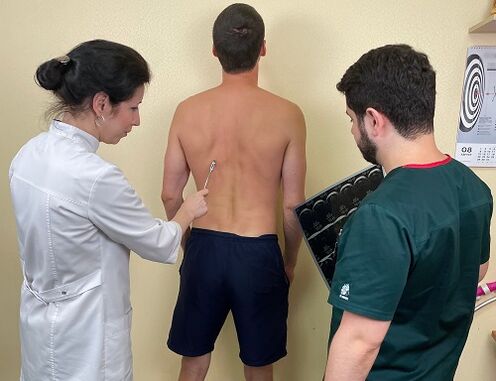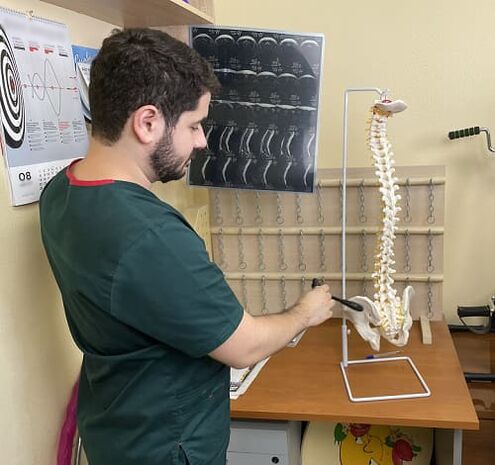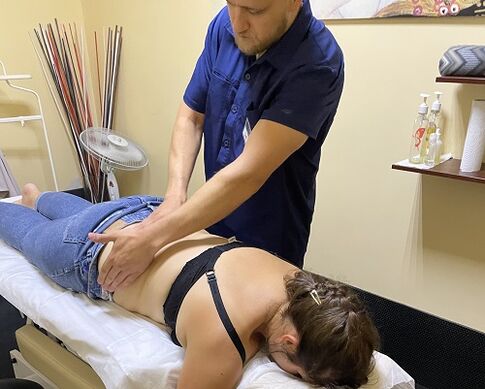
Osteochondrosis of the cervical spine is common today among city residents, office workers and people who spend several hours a day in one position.
But it can also develop in youth. Therefore, everyone should know what cervical osteochondrosis is and how it is treated in order to seek help in time and stop the development of unpleasant symptoms and the destruction of the joints of the neck and shoulders.
Before deciding what to do if osteochondrosis of the cervical spine has worsened and you feel pain in the neck, you should visit a doctor and undergo a diagnosis.

Diagnosis
Is it possible to permanently cure osteochondrosis of the cervical spine, is it possible to treat the neck and how to do it? The doctor will inform you after making a complete diagnosis. Due to the similarity of symptoms with other diseases, attention is paid to determining the diagnosis. A patient who comes to a neurologist complaining of neck pain and dizziness will have to go through several stages before complex therapy is developed for him.
Inspection
At the first visit to the neurologist, an initial examination of the patient is performed. The doctor's task is to determine the diagnosis, the possible cause of the appearance and development of the disease, as well as to exclude other diseases with similar symptoms.
Specialist during inspection:
- Listen to complaints about health. Clarifies symptoms, frequency, intensity. Try to determine what triggers the attack to begin.
- Clarify the details of the anamnesis,will determine the characteristics of the patient's daily life and the presence of concomitant diseases.
- Check the functioning of your reflexes.focusing on those whose work is influenced by the nerve endings located in the neck.
- Examines muscle strength and tenderness,You will identify areas of numbness or a tendency to spasm or excessive relaxation.
- Will performtest of the vestibular apparatus,which is also affected by the development of osteochondrosis.
During the process, the doctor examines the condition of the muscles. Its thinness or swelling indicates problems with nerve sensitivity. Another important symptom is pain and dizziness when turning or tilting the head.
Laboratory diagnosis

It is possible to prescribe an error-free treatment regimen during exacerbation of cervical osteochondrosis and provide effective assistance only by identifying the causes of the destruction of the vertebrae and intervertebral discs. And for this, additional research is carried out in the laboratory.
To understand the development of the disease, a series of studies are carried out:
- Total and ionized calcium.
- Osteocalcin and osteoprotegerin– substances – indicators that bones are gradually being destroyed and cartilage tissue is thinning. If its amount in the blood is higher than normal, the disease will continue to develop.
- Creatine kinase– an indicator of damage to muscle tissue. If osteochondrosis has already provoked the development of myositis and seriously threatens the muscles, this indicator in the blood will also increase.
- Research on microelements and vitamins.It is carried out to determine which of the microelements and vitamins necessary for metabolism and tissue repair are missing in the patient's body.
instrumental studies
Having found out the rate of development and the causes of chondrosis, the doctor must determine the state in which the patient was admitted.
For this, hardware studies of the spine and intervertebral discs are carried out:
- Bone scan.It shows serious changes in bone structure, emerging deformations and neoplasms.
- MRI imageEvaluates the condition of nerve roots, bulging discs, vertebral inversions, and small tumors.
- Ultrasound of the cervical blood vessels.Blood vessels are carried out to determine their permeability and therefore the ability to supply the brain with necessary oxygen and nutrients.
- Electroneuromyography. A current load passes through the nervous system, which is unpleasant, but shows the level of passage of nerve impulses and the speed of their passage to the muscles, and therefore the degree of damage.

There are many tips on how to get rid of cervical osteochondrosis forever, quickly relieve pain, eliminate dizziness and combat attacks of weakness at home. But it is necessary to understand that this is a serious disease that develops individually, and therefore the treatment regimen must be selected by a professional. Therefore, when the first symptoms appear, without wasting time with traditional methods, it is advisable to go to the clinic.
Treatment
Almost everyone who was diagnosed with "chondrosis of the cervical spine" thought about how to cure the degenerative disease, whether and how it can be treated, and whether it is possible to forget about neck pain forever if you follow the advice of doctors. The answer depends on the scenario.
In the first and second stages, there are methods that allow you to treat chondrosis of the cervical spine in men and women with good results for the neck at home.
The doctor's goal is to relieve pain, prevent further destruction of cartilage and bone tissue, and try to restore, if possible, the intervertebral discs to restore mobility. To solve this problem, complex therapy is always used, but sometimes surgical intervention is added to conservative treatment methods.
Pharmacotherapy
Very often, men and women, at the stage of exacerbation of inflammation due to osteochondrosis of the cervical spine, choose treatment at home, using a strong analgesic, but what to do if neck pain returns? What treatment will be effective? The only correct answer is an appointment with a neurologist.
When chondrosis worsens, it is important not only to eliminate the symptoms, but also to cure what causes them, and therefore the range of medications is not limited to pain relievers.For the treatment of cervical osteochondrosis, the following is used:
- Non-steroidal anti-inflammatory drugs,helping to relieve pain and reduce tissue inflammation at the site of pinched nerve endings.
- Local gels and ointments,which must be prescribed by a doctor, since not all of them are compatible with medications taken orally.
- Muscle relaxantsIt will allow you to relax spasmed muscles and release compressed nerves and arteries, eliminate stiffness, pain and dizziness.
- ChondroprotectorsThey are used to stop the destruction and restore the cartilage tissue of the intervertebral discs and prevent the appearance of hernias.
- Vitamin complexesThey are used to improve tissue nutrition, accelerate recovery and enhance the effect of drugs, allowing the use of smaller doses.
If a patient is admitted with unbearable pain, a block based on hormonal analgesics will be used.

Non-pharmacological treatment
Another method that has excellent reviews from men and women and is often used in the treatment of osteochondrosis of the cervical spine and shoulder girdle at home is physiotherapy, but the doctor must also decide how and what to treat. . After all, there are no universal physiotherapy methods that suit everyone. A set of effective methods is selected specifically for each patient.
The most effective are considered:
- Electrophoresis with analgesics.
- Physiotherapy. The set of exercises and their complexity varies depending on the stage of development of osteochondrosis.
- Massage and self-massage.
- Magnetotherapy.
Surgery for osteochondrosis
At certain stages of the development of cervical osteochondrosis, what is prescribed for neck and back pain does not help, in which case you can take heavier medications or resort to a radical but effective method - surgery. The operation is prescribed for patients with irreversible changes in the structure of the spine. At the same time, collapsed and fused vertebrae, hernias and neoplasms that appear threaten human life and reduce its quality.

The surgeon will be able to remove bone growths, hernias, tumors, and pinched nerve endings. After this intervention, the patient will undergo rehabilitation, during which it is necessary to follow the doctor's recommendations; Otherwise, even the operation will not produce the desired effect.
How and how to treat cervical chondrosis at home or in the hospital, what to do to relieve pain in the neck and shoulders, get rid of dizziness and relieve inflammation of the vertebrae, what helps and what will harm, the doctor must decide. Using other methods and means, you risk your health, because with such a disease, therapy must be designed taking into account the personal characteristics of the patient.
Prevention
In order not to know what the treatment is for cervical osteochondrosis, it is worth thinking about prevention in advance. The disease is usually hereditary, but following the recommendations will prevent it from developing or stop it in the early stages.
Traditional preventive measures for diseases of the spine:
- Ensure healthy physical activity. Light workouts 2-3 times a week. It is worth choosing a sport aimed at strengthening the muscle corset. Swimming, yoga, Pilates, cycling and skating are suitable. In this case the loads should not be too heavy.
- Daily activity even during sedentary work. To do this, just do exercises and walk.
- Monitor your posture, not only while you walk, but also while you work.
- An ergonomic workplace in which the space occupied by attention is located so that the neck is not in a tense state.
- Avoid lifting heavy objects and excessive physical exercise.
- Provide a comfortable sleeping place with an orthopedic mattress and pillows for healthy sleep and complete rest.
- Give up bad habits, since alcohol, nicotine and drugs have an extremely negative effect on joints, bones and blood vessels.
- Change your diet. It is advisable to reduce the amount of salt, spices, sugar and flour consumed in the daily menu. Avoid fast foods, especially those cooked in oil, sweet soft drinks and juices.
- Create a menu taking into account the need for microelements and vitamins. Pay attention to vegetables and fruits, lean fish and meat.
- Drink clean water in sufficient quantities.
- Once every few months, take a maintenance massage course. Perform self-massage regularly if you feel tired in the shoulder area.
If, despite all attempts to maintain health, osteochondrosis of the cervical spine appears, only a doctor can determine how long the disease will be treated after a thorough diagnosis. However, to prevent the recurrence of an exacerbation, a person with such a diagnosis will have to remember the rules of healthy living throughout his life.

























